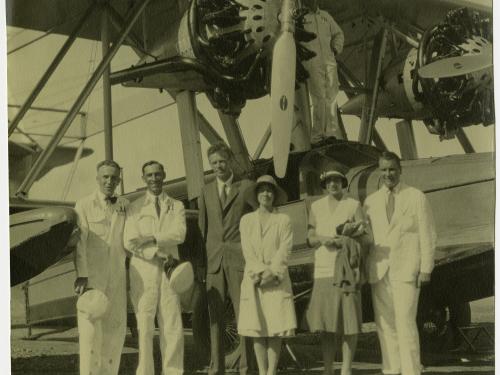
Stories of daring, stories of technological feats, stories of prevailing against the odds ... these are the stories we tell at the National Air and Space Museum. Dive in to the stories below to discover, learn, and be inspired.
Showing 1191 - 1200 of 1761

June 17, 2016
The Northwestern Aeronautical Corporation (NAC) in St. Paul, Minnesota documented company life during WWII in a series of wooden scrapbooks created for company president John E. Parker. The company supported a softball league with batting averages to shame Ted Williams and a league-leading hockey team. For Thanksgiving, employees received a turkey, compliments of the company. And in June 1945, the company sponsored the Miss Northwestern beauty contest.

June 16, 2016
Among the treasures found within the special collections of the DeWitt Clinton Ramsey Room, a branch of the Smithsonian Libraries located at the National Air and Space Museum, is a collection of oversized scrapbooks with an interesting and complicated history. Originally bound in one volume, William Upcott’s Scrapbook of Early Aeronautica captures the history of lighter-than-air aircraft and aeronautics from 1783 to the 1840s through a rich collection of newspaper clippings, articles, illustrations, and letters.

June 16, 2016
One of our most enduring and popular exhibits has been a piece of the Moon that you can touch. The rock, on loan from NASA, is one of only a few touchable lunar sample displays in the world. In fact, it was the very first touchable Moon rock exhibit when it opened to the public in 1976.

June 16, 2016
On October 7, 1929, Anne Morrow Lindbergh gazed out the window of a Sikorsky S-38 flying boat, entranced by the view before her: gleaming stone structures only recently freed from the thick tropical vegetation of the Yucatan peninsula in Mexico—Chichén Itzá, a remnant of the Mayan civilization that thrived there between 750 and 1200 AD. Her husband Charles A. Lindbergh piloted the aircraft that skimmed just above the ruins and treetop canopy.

June 16, 2016
For more than four decades, the Smithsonian’s National Air and Space Museum has celebrated the greatest achievements in aviation and space history.

June 16, 2016
I’m snatching moments to write this from Chile, sitting on the floor of the airport, or bouncing up winding mountain roads in a van. I’m here as an Astronomy in Chile Educator Ambassador, with eight other ambassadors.

June 16, 2016
“God bless you,” was the way in which “Mother” Tusch said farewell to pilots who visited her at her Berkeley, California cottage from 1915 to 1950, so it is fitting that the phrase is engraved on this plaque found among her vast collection of aviation memorabilia.

June 15, 2016
In a recent blog post, Kathleen Hanser told the story of the “Shrine of the Air” in Berkeley, California, and highlighted various artifacts from “Mother” Tusch’s house that became a part of our collections. The paper documents from Tusch’s house can be found in the National Air and Space Museum Archives as part of theMary E. “Mother” Tusch Collection (Acc. No. XXXX-0128).

June 15, 2016
Half a century ago, in February and June 1966, robotic spacecraft first landed on the Moon. I vividly remember those events from my days as a 14-year-old space buff. On February 3, the Soviet Union’s Luna 9 thumped down on the vast lava plain known as Oceanus Procellarum (Ocean of Storms), after a number of failed attempts. A Soviet stamp shows its landing configuration, which used air bags to cushion its fall. On the right is the first picture transmitted, from the turret camera in the cylinder on top.

June 15, 2016
During the Mercury, Gemini, and Apollo missions, one of NASA’s concerns was the safety of its crews, something it monitored rigorously through the use of biomedical instrumentation. As initial flight planning commenced in 1959, biomedical equipment capable of transmitting from space did not exist. NASA quickly brought together medical staff and hardware engineers to develop biomedical technology.